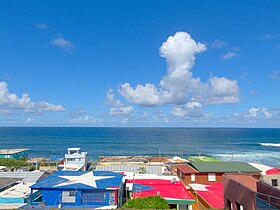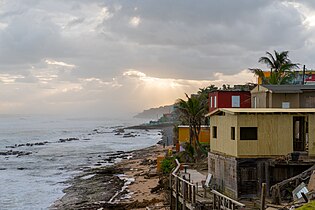La Perla, San Juan, Puerto Rico


La Perla is a historical shanty town astride the northern historic city wall of Old San Juan, Puerto Rico, stretching about 650 yards (600 m) along the rocky Atlantic coast immediately east of the Santa Maria Magdalena de Pazzis Cemetery and down the slope from (north of) Calle Norzagaray.
La Perla was established in the 18th century. Initially, the area was the site of a slaughterhouse because the law required the homes of former slaves and homeless non-white servants – as well as cemeteries – to be established away from the main community center; in this case, outside the city walls. Sometime after, some of the farmers and workers started living around the slaughterhouse and shortly established their houses there.
History, location and description[]

Located inside the Old San Juan Historic District, La Perla (The Pearl) was originally the site of a slaughterhouse, called El Matadero. It was built in the 18th century outside the walls of San Juan by slaves who were required to live outside the city. Slaves built homes and lived near the slaughterhouse and later jíbaros, (Puerto Rican farmers) who moved to San Juan, lived there.[1]
La Perla belongs to and consists of the northernmost stretches of Mercado subbarrio (west) and San Cristóbal subbarrio in San Juan Antiguo barrio. San Juan Antiguo barrio is located on Isleta de San Juan, an island off San Juan, the capital of Puerto Rico, and it is connected to the mainland by bridges and causeways. La Perla is in the Old San Juan Historic District which is managed by US National Park Service.[2]
La Perla has sometimes been described as a slum and as a shantytown, because many homes have been built without proper permits. While tourists have normally been deterred from visiting La Perla, some entrepreneurs have tried to change its image with art galleries, cafés and restaurants. La Perla Impacto Comunitario, a local community group has coordinated tours.[1][3][4]

Only four access points exist into La Perla: one through the Santa María Magdalena de Pazzis Cemetery, and the others from Calle Norzagaray, named after Spanish soldier and colonial governor, Fernándo Norzagaray y Escudero.[1]
- Calle Tiburcio Reyes (western border, along the outside of the old city wall)
- Calle San Miguel (mostly in the western part, along the north)
- Calle Bajada Matadero (mostly in the western part, along the south)
- Calle Lucila Silva (mostly in the western part, east-west through the middle, too narrow for cars)
- Calle Augustin O Aponte (eastern part)
Despite the fact that many homes in La Perla have been built without proper permits, residents of La Perla do have utility services. Garbage pickup is done regularly in the neighborhood, which in 1973 consisted of about 900 houses and 3,300 residents.[5]
La Perla has a community-oriented music recording studio, El Estudio D' Oro, which serves as a free of cost music production workshop for all ages. El Estudio D' Oro is also home to the FM urban radio show, Hip Hop 787 La Verdadera Escuela, which is broadcast live from the studio on WVOZ Mix 107.7 FM.
In June 2011, the Drug Enforcement Agency with other agencies targeted 50 properties in La Perla and indicted 114 people from La Perla for drug trafficking.[6] The area has a reputation for being dangerous, but the popular 2017 Despacito music video filmed there made it a curiosity amongst tourists, with some wanting to venture in to see where the video was filmed.[1][7][8]
In 2016, students of architecture at universities in Puerto Rico asked children for their ideas on how to improve their favorite areas of La Perla.[9][10][11] El Bowl is a colorful, bowl-shaped cemented area in La Perla, used for skateboarding on weekdays, and then filled with water on weekends, to serve as a pool.[1]
On September 20, 2017, Hurricane Maria hit Puerto Rico and La Perla "looked like it was hit by a bomb".[12] "Despacito" (the song title that translates to "slowly") was also used to highlight and criticize the slow United States response to the destruction at La Perla caused by Hurricanes Irma and Maria, where the video was filmed.[13] The National Park Service assisted the few residents of La Perla with tarps soon afterwards.[2]
Census[]
In terms of the United States 2000 Census, La Perla is composed of Census blocks 3001 through 3010 (Block group 3, Census tract 4, San Juan, Puerto Rico). A population of 338 was reported, 198 housing units (29 unoccupied), and 169 households, on an area of 80,028 square yards (16.53 acres; 66,914 m²).
La Perla belongs to and consists of the northernmost stretches of the subbarrios Mercado (west) and San Cristóbal in San Juan Antiguo barrio. The dividing line between the subbarrios is the imagined extension of Calle San Justo to the north beyond the old city wall to the Atlantic coast. The eastern part consists of Census blocks 3002, 3009 und 3010, with a population of 64, 35 housing units (4 unoccupied), and 31 households, on 41,348 square yards (8.5 acres; 34,572 m²).
Media and popular culture[]

La Perla was the true site of the fictional "La Esmeralda" barrio depicted in Oscar Lewis's sociological work, "", describing the lives of Puerto Rican slumdwellers and prostitutes. From La Perla, through taped interviews with dozens of intertwined family members who lived there in the 1940s-1960s, Lewis wrote an award-winning and controversial book. Controversial because his award-winning book, written in 1967, would influence the way people viewed Puerto Rican women and Puerto Ricans, in general. "Many who read his book assumed the whores of La Perla were typical of all Puerto Rican women."[14]
In 1978, salsa singer Ismael Rivera had a hit song, written by composer Catalino Curet Alonso, in honor of this community, and named after it. In 2009 Urban Music group Calle 13 released another tribute song, also named La Perla, in collaboration with Ruben Blades. In the song, Blades references Rivera's early effort; in the song's video, Blades pays his respects to Curet by visiting his tomb at the community's Santa María Madgalena de Pazzis cemetery.
Canadian singer Nelly Furtado along with Calle 13 band member Residente filmed the music video to the remix of Furtado's song No Hay Igual on 26 June 2006 in La Perla. Residente said he hoped that the video would help them both reach new audiences: "It's a good opportunity for us both. More than the North American market, the European market really interests me and her because her family is Portuguese."[15] The video was directed by Israel Lugo and Gabriel Coss, photographed by Sonnel Velazquez and produced by María Estades.[16]
In Giannina Braschi's political allegory United States of Banana (2011), the Puerto Rican prisoner Segismundo is born in the dungeon of the Statue of Liberty as the illegitimate child of a woman from La Perla and the Governor of Puerto Rico Luis Muñoz Marín.[17][18]
The Puerto Rican classic play by La Carreta (1953) by René Marqués takes place in La Perla. A poor family moves from their farm to La Perla, and then to the Bronx for the better life that they never quite find.[19]
The motion picture The Vessel (film) starring Martin Sheen about a tidal wave that destroys a small town was filmed in La Perla in 2013.
With more than 6 billion views on YouTube, La Perla became world-known with the music video for the song Despacito being filmed there.[20][7]
Gallery[]

Comunidad La Perla sign

Top of homes in La Perla
Residences in La Perla

La Perla neighborhood in San Juan

La Perla coastline in 2018

La Perla from the sea in 2012

Youth playing basketball at a court at La Perla
See also[]
References[]
- ^ Jump up to: a b c d e "Visiting La Perla Neighborhood in Old San Juan". Discover Puerto Rico. Retrieved 2021-04-30.
- ^ Jump up to: a b "NPS Incident Management Team Hurricane Update for the Caribbean Parks, Saturday, October 7, 2017 – 6pm". Office of Communications (U.S. National Park Service). 2017-10-07. Retrieved 2021-04-30.
- ^ "La Perla en Puerto Rico, el renacimiento de uno de los barrios más peligrosos del Caribe". BBC News Mundo (in Spanish). 2015-12-17. Archived from the original on 2021-01-04. Retrieved 2020-07-22.
- ^ "40 days, $80K transform La Perla community in San Juan". News is my Business. Archived from the original on 2020-09-25. Retrieved 2020-07-22.
- ^ Cordasco, F.; Bucchioni, E. (1973). The Puerto Rican Experience: A Sociological Sourcebook. Littlefield, Adams quality paperback. Rowman and Littlefield. p. 109. ISBN 978-0-87471-162-2. Retrieved 31 August 2019.
- ^ "DEA Investigation Results In 114 Individuals Indicted For Drug Trafficking In Old San Juan's La Perla Ward". DEA. 2011-06-29. Archived from the original on 2021-04-06. Retrieved 2021-04-28.
- ^ Jump up to: a b "Tourists seeking 'Despacito' discover Puerto Rico's La Perla". Yahoo News. 2018-08-26. Archived from the original on 2020-08-03. Retrieved 2020-07-22.
- ^ Macor, Leila (2017-07-31). "Tourists seeking 'Despacito' discover Puerto Rico's La Perla". Business Insider. Retrieved 2021-04-28.
- ^ "La participación en el diseño de espacios que habitamos". Archived from the original on 2019-08-31. Retrieved 2019-08-31.
- ^ "Archived copy". Archived from the original on 2019-08-31. Retrieved 2019-08-31.CS1 maint: archived copy as title (link)
- ^ Derr, Victoria; Chawla, Louise; Mintzer, Mara (September 18, 2018). "Placemaking with Children and Youth: Participatory Practices for Planning Sustainable Communities". New Village Press. Archived from the original on August 5, 2020. Retrieved August 31, 2019 – via Google Books.
- ^ Lima, Lioman (2017-09-23). ""Parece que cayó una bomba": así quedó La Perla, el popular barrio de Puerto Rico donde se filmó Despacito, tras el paso del huracán María". BBC News Mundo (in Spanish). Archived from the original on 2020-07-22. Retrieved 2020-07-22.
- ^ "Post-Hurricane Help Slow To Arrive In 'Despacito' Neighborhood". NPR.org. Archived from the original on 2017-10-03. Retrieved 2017-10-02.
- ^ Steiner, S. (1974). The Islands: the worlds of the Puerto Ricans. Harper Colophon books. Harper & Row. p. 362. ISBN 978-0-06-014079-3. Retrieved 31 August 2019.
- ^ "Furtado films video in Puerto Rico". Jam!. Canoe.ca. Archived from the original on June 29, 2006. Retrieved 10 March 2013.
- ^ "Nelly Furtado graba video en La Perla en el Viejo San Juan junto con Residente de Calle 13" Archived 2011-10-04 at the Wayback Machine (Spanish). ¡Boom! Online. 26 June 2006. Retrieved 14 November 2006.
- ^ Mendoz de Jesus, Ronald; Aldama, Frederick Luis (2020). "Free-dom: United States of Banana and the Limits of Sovereignty" in Poets, Philosophers, Lovers. Pittsburgh: Pittsburgh. pp. 145–160. ISBN 9780822946182.
- ^ Braschi, Giannina. (2011). United States of Banana. Las Vegas, NV: AmazonCrossing. ISBN 978-1-61109-067-3. OCLC 760912360.
- ^ Pethick, Kris. "The Great Works of René Marqués". Culture Trip. Archived from the original on 2020-10-09. Retrieved 2020-10-07.
- ^ Contreras, Felix (December 13, 2017). "The 100 Best Songs Of 2017". NPR. p. 3. Archived from the original on December 5, 2018. Retrieved December 5, 2018.
Bibliography[]
- Florian Urban (2015). "La Perla: 100 years of informal architecture in San Juan, Puerto Rico". Planning Perspectives. 30. doi:10.1080/02665433.2014.1003247.
External links[]
 Media related to La Perla (San Juan, Puerto Rico) at Wikimedia Commons
Media related to La Perla (San Juan, Puerto Rico) at Wikimedia Commons- La Perla Impacto Comunitario on Facebook
Coordinates: 18°28′09″N 66°06′58″W / 18.46917°N 66.11611°W
- Old San Juan, Puerto Rico
- Geography of San Juan, Puerto Rico
- 18th-century establishments in Puerto Rico
- Populated places established in the 18th century







